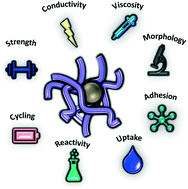Molecular design principles for polymeric binders in silicon anodes
Abstract
Silicon anodes potentially offer a volumetric energy storage capacity significantly greater than that of commercial graphitic carbon anodes, but silicon electrodes exhibit poor stability under reversible charging and discharging. This has been attributed to several factors including large volume changes of silicon during battery operation, the non-passivating nature of the Si surface which can result in uncontrolled growth of solid-electrolyte interface layers, and reactivity between the binder and lithiated silicon. To address these challenges, researchers have developed innovative compositions and architectures of polymer binders aimed at increasing storage capacities and improving stability. Polymer binders serve multiple functions in battery electrodes including maintaining adhesion between the electrode and current collector and cohesion of the electrode as a whole, ensuring the stability of the solid electrolyte layer that forms on the surface of silicon, and in some cases providing electronic and ionic conductivity. The goal of this review is to identify and critically evaluate underlying molecular design principles applied to the development of polymeric binders for silicon anodes. Molecular design principles include molecular functionalities, architectures, or compositions that can produce a desired physical or chemical property. The review specifically focuses on the molecular features of binders that facilitate self-healing, electronic conductivity, mechanical performance, and electrochemical performance.



 Please wait while we load your content...
Please wait while we load your content...